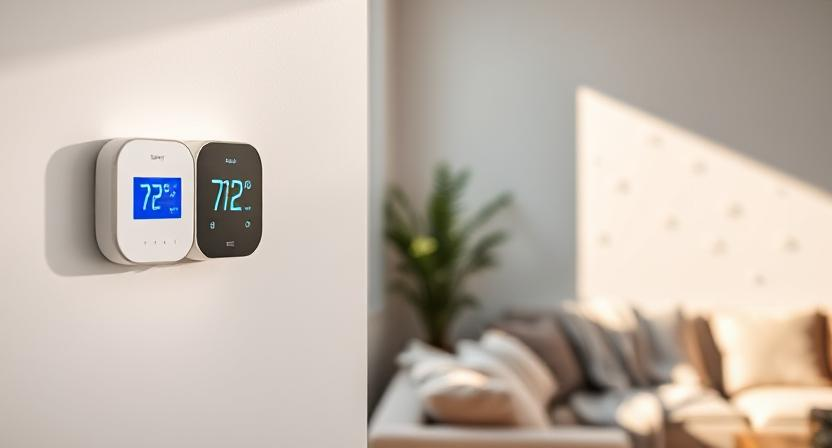I’ve found that for winter, it’s best to set your thermostat to 68°F while you’re home and lower it to about 63-65°F at night. In summer, aim for 78°F when you’re home, and raise it to around 85°F when you’re away for longer periods. These settings help balance comfort with energy savings. If you’re curious about optimizing your home environment further, there’s plenty more beneficial information to explore.
Find out how solar energy can benefit your household.
🔗 Learn More
Recommended Thermostat Settings for Winter
When I think about winter thermostat settings, I recommend keeping it at 68°F while you’re home and awake to strike a balance between comfort and energy savings.
This thermostat setting not only keeps you comfortable but also promotes energy efficiency. If you lower the temperature to 63-65°F during sleep, you can save money on heating costs.
Each degree you reduce can save you about 3% or more on your expenses. When you’re away for extended periods, setting the thermostat to 55°F can maximize savings.
Additionally, reducing the temperature by 7-10°F for 8 hours can lead to up to 10% savings on heating bills annually. These adjustments can make a real difference in your winter energy costs.
Recommended Thermostat Settings for Summer

To keep your home comfortable and energy-efficient during the summer, I recommend setting your thermostat to 78°F while you’re home.
When you’re away for more than four hours, consider raising the thermostat to 85-88°F to save energy and reduce cooling costs.
Remember, setting your thermostat colder than 78°F won’t cool your home faster, and it can lead to unnecessary expenses.
Maintaining a consistent thermostat setting not only enhances comfort but also prevents strain on your HVAC system, improving overall energy efficiency.
| Thermostat Setting | Purpose |
|---|---|
| 78°F | Comfort at home |
| 85-88°F | Save energy when away |
| < 78°F | Unnecessary expenses |
| Consistent setting | Prevent HVAC strain |
| 82°F | ideal sleep comfort |
Ideal Temperature for Sleeping
When it comes to getting a good night’s sleep, I’ve found that the temperature in my bedroom plays a huge role.
In winter, I aim for around 65°F, while in summer, I adjust to about 78°F to stay comfortable. These small changes not only improve my sleep quality but can also help save on energy costs.
Optimal Sleep Temperature Range
Finding the right temperature for sleeping can make a significant difference in how well I rest at night.
The ideal temperature range is between 60-67°F, which promotes comfort and better sleep quality. Here’s what I’ve learned about best sleep temperatures:
- In winter, set the thermostat around 65°F to save on heating costs.
- During summer, aim for about 78°F for energy efficiency.
- A cooler environment can help reduce wakefulness.
- Adjustments within the ideal range might be necessary for individual comfort.
- Consistency in temperature can enhance overall sleep quality.
Seasonal Sleep Temperature Adjustments
Adjusting your sleep environment according to the seasons can make a big difference in your overall comfort and rest.
For winter, I aim for an ideal sleep temperature of around 65°F, which really helps with sleep quality.
In summer, I raise it to about 78°F to maintain a cool atmosphere without sacrificing energy efficiency. During spring and fall, I stick to the same temperatures—65°F when it’s cool and 78°F when it warms up.
By adjusting my thermostat settings before bed, I also enjoy energy savings by reducing HVAC operation during the night.
These seasonal adjustments not only enhance my comfort but also support a better night’s sleep, making it easier to wake up refreshed.
Effects on Sleep Quality
Although many factors influence sleep quality, the temperature of your bedroom plays an essential role in how well you rest.
I’ve found that sticking to the ideal temperature for sleeping—between 60-67°F—can greatly improve my sleep. Here’s why it matters:
- Cooler temperatures promote deeper sleep cycles.
- A thermostat setting for summer around 78°F balances comfort and energy efficiency.
- In winter, keeping the thermostat setting at 65°F enhances comfort.
- Each degree adjustment can impact sleep quality.
- Better sleep leads to increased productivity and mood.
Best Temperature for Houseplants
When it comes to caring for houseplants, the right temperature can make all the difference. I’ve found that the ideal thermostat temperature for most houseplants is between 60-75°F.
This range promotes healthy growth and keeps them thriving. It’s essential to set the temperature for your thermostat to avoid extremes—never let it drop below 50°F or rise above 85°F, as this can stress your plants.
Consistency is key; fluctuations can harm their health. Additionally, pairing the right homes temperature with adequate humidity levels is important.
If you want to be energy efficient, consider how adjusting your thermostat can also lower your energy bills while keeping your plants happy and healthy!
Optimal Temperature for Pets
Many pet owners might not realize how essential the right thermostat settings are for their furry friends’ comfort and health.
Keeping the temperature just right can greatly impact their well-being. Here are some key points to contemplate:
- Recommended temperature range: 64°F to 78°F
- Ideal thermostat setting for summer: 78°F
- Ideal thermostat setting for winter: 68°F
- Monitor pets closely during temperature extremes
- Some breeds are more sensitive to heat or cold
Comfortable Room Temperature for Infants
When it comes to keeping infants comfortable, I find that maintaining a room temperature between 65°F and 74°F is essential for their safety and health.
It’s important to monitor the environment to prevent overheating, which can be a risk factor for SIDS. Plus, dressing them in light layers can help regulate their body temperature effectively.
Ideal Temperature Range
Ensuring your infant is comfortable means keeping the room at an ideal temperature range, which is typically between 65-74°F.
This range is vital for their well-being, especially since infants are sensitive to temperature fluctuations. Here are some key points to take into account:
- Aim for around 68°F during winter for cozy heating.
- In summer, keeping it around 78°F helps prevent overheating.
- Regularly check your infant’s ears or chest to gauge their comfort.
- Consistency in temperature settings is essential for better sleep.
- Use fans or air conditioning for effective cooling when needed.
Safety and Health Considerations
While it’s easy to overlook the importance of room temperature, maintaining a safe and comfortable environment for your infant is fundamental for their health.
The recommended thermostat settings for infants fall between 65°F and 74°F, which is essential for preventing overheating—a known risk factor for Sudden Infant Death Syndrome (SIDS).
When adjusting your thermostat, keep in mind that infants can’t regulate their body temperature as effectively as adults.
To guarantee a safe temperature for sleeping, dress them in light layers and avoid heavy blankets.
Regularly checking the temperature helps you stay comfortable while managing heating and cooling costs, ultimately saving on energy costs. Keeping your infant’s room within this range is crucial for their well-being.
Monitoring Room Conditions
After establishing a safe temperature range for your infant, monitoring the room conditions becomes essential for their ongoing comfort. The ideal room temperature should be between 65-74°F, as fluctuations can disrupt their sleep patterns. I always make it a point to:
- Check the room temperature regularly
- Use air conditioning or fans, ensuring airflow isn’t directed at the infant
- Dress them in lightweight layers to adapt to changing temperatures
- Monitor their body temperature by checking their ears or chest
- Avoid heavy blankets that might cause overheating
Keeping these factors in mind helps create a comfortable environment for my little one, ensuring they sleep soundly and safely.
Importance of Thermostat Placement
The placement of your thermostat is crucial for maintaining a comfortable home environment. For accurate readings and efficient temperature settings, I recommend installing your thermostat on an interior wall, away from direct sunlight and air vents.

This helps avoid the influence of external heat sources and guarantees your central heating system works effectively.
It’s best to steer clear of kitchens and bathrooms, as their fluctuating temperatures can lead to incorrect readings.
Positioning your thermostat centrally allows for better regulation across all rooms, enhancing comfort and energy saving.
Additionally, consider using external room sensors for frequently used areas, giving you more precise control and improved comfort throughout your home.
Benefits of Using a Smart Thermostat
Smart thermostats offer a range of benefits that make managing your home’s temperature easier and more efficient.
I’ve found that integrating one into my home has markedly impacted my energy bills. Here are some key advantages:
- Save on heating and cooling costs: Average savings of 8% by adjusting based on occupancy.
- Mobile app control: Adjust your thermostat remotely for maximum convenience.
- Energy tracking: Get insights into your daily, weekly, and monthly energy usage.
- User-friendly installation: Complete installation in less than an hour, often without professional help.
- Advanced programming: Set specific temperature schedules to optimize comfort and reduce waste.
With a smart thermostat, you can effortlessly manage your home’s temperature and enjoy increased efficiency!
Tips for Energy Savings in All Seasons
While managing energy costs can feel challenging, there are simple strategies I’ve found that really help save on heating and cooling throughout the year.
In winter, I set my thermostat to 68°F when I’m home and lower it to 60-65°F while I sleep or when I’m away.
This can save up to 10% on heating costs annually. During summer, I keep it at 78°F at home and raise it to 85°F when I’m out.
I also discovered that lowering my thermostat by 7-10°F for 8 hours boosts energy savings. Using a programmable thermostat makes these temperature adjustments effortless, ensuring I’m optimizing energy savings without sacrificing comfort.
Small changes can really make a big difference in reducing heating costs and cooling expenses.
Frequently Asked Questions
What Should I Set My Thermostat at in the Summer and Winter?
Think of your thermostat as a friendly guide through the seasons. I set mine to 78°F in summer and 68°F in winter to balance comfort and energy savings, keeping my home cozy year-round.
Is 72 Too Cold for AC in Summer?
I find 72°F a bit too cold for summer. It can hike up my energy bills and strain my AC. I usually aim for around 78°F for comfort without breaking the bank.
Is 78 Too Hot for a House?
Feeling like I’m melting under the summer sun, I’ve found 78°F can be warm for some. It really depends on personal comfort; adjusting it slightly might just keep those sweaty moments at bay.
What Is the Best Setting for AC and Heat?
When it comes to setting my AC and heat, I find keeping the thermostat at 78°F in summer and 68°F in winter works best for balancing comfort and energy savings. It’s a simple yet effective approach.





